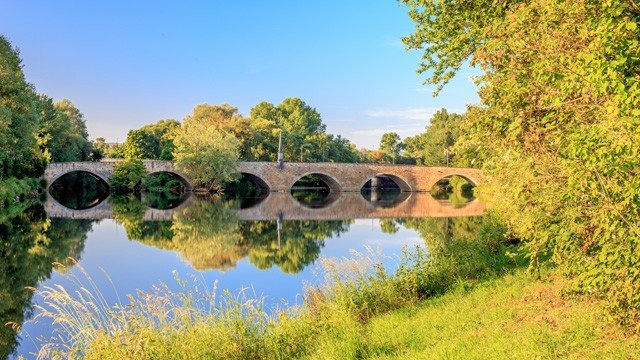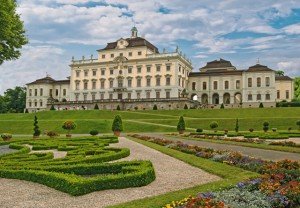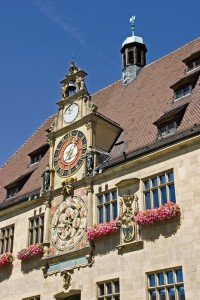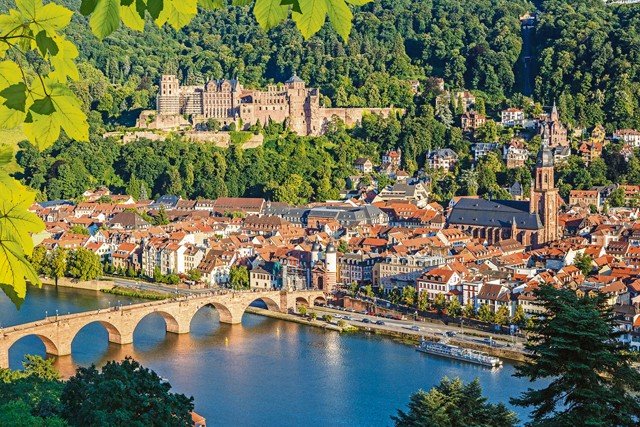
By Teri Weiss
Special to the Citizen
Editor’s Note: This is the second and final instalment of a two-part series exploring tourist-worthy destinations along the Neckar River.
Mid, Upper Neckar valley towns from Stuttgart northward
Between Stuttgart and Lauffen, the Neckar River carves out a remarkably scenic valley of meadows and orchards on the shore and vineyards on steep-sided slopes.
Ludwigsburg
Ludwigsburg is located about 12 kilometers, or 7.5 miles, north of Stuttgart. With more than 87,000 inhabitants, Ludwigsburg makes for a historic baroque, but yet vibrant and modern city. Today, Ludwigsburg, which was originally founded in the early 18th century, can be considered a place where past and present unites. Three beautiful palaces, the Baroque “Residenz,” or residential palace, the former hunting lodge and summer residence “Favorite” and the lakeside castle Monrepos, can be toured and offer special events year round. Romantic parks such as the 75 acres of the flowering Baroque and Fairy Tale Garden, bustling shopping streets and festivals attract visitors. For more information, visit here.

Marbach am Neckar
Marbach is known as the birthplace of the classical poet and dramatist Friedrich Schiller, commemorated by the Schiller-Nationalmuseum und Deutsches Literaturarchiv (Schiller National Museum and German Literature Archive). The town has a picturesque center with several churches, with “Alexanderkirche” dating back to the 16th century and many historic houses, including the one in which Schiller was born. Leisure activities are available in and around Marbach providing nature between vineyards, the Neckar River and forests perfect for hiking and biking. For more information, visit here.
Besigheim
Besigheim is situated 13 kilometers north of Ludwigsburg at the confluence of the Neckar and Enz rivers. It was founded in the 12th century as a well-defended walled city. Besigheim counts many historic buildings and a town hall dating back to 1459. There are two medieval towers, a Gothic church, a cobblestoned market place and more historic sites to discover. For more information, visit here.
Hessigheim
Hessigheim am Neckar has a long wine-making tradition on steep slopes dating back centuries and is well known for its highly praised wines. The region around Hessigheim is perfect for rock-climbing, hiking and biking along the Neckar River or through the vineyards. For more information, visit here.
Lauffen am Neckar
Lauffen am Neckar is situated nine kilometers, or six miles, southwest of Heilbronn. The town is famous as the birthplace of the poet Friedrich Hölderlin and for its many apple orchards and quality wines – in particular the “Lauffener Katzenbeißer Schwarzriesling.” For more information, visit here.
Bad Wimpfen
Bad Wimpfen is located south of Heilbronn on land once cultivated by the Celts and Romans. The enormous medieval imperial palace, the largest north of the Alps, with its red and blue towers loom over steep cobblestoned streets of the old town center. A climb of the Blauer Turm’s, or blue tower’s, 167 steps provides a dazzling view of the Neckertal. Two original Luther Bibles are on display at the Kirchenhistorisches Museum, or Historical Church Museum. Bad Wimpfen has a number of warm and revitalizing saltwater springs and a “Schweinemuseum,” or pig museum — in Germany, pigs supposedly bring good luck. For more information, visit here.
Heilbronn
Heilbronn is a former free imperial city and is the economic center of the Heilbronn-Franken region that includes most of northeast Baden-Württemberg. Heilbronn is known for its wine industry and is nicknamed “Käthchenstadt,” Kathy town, afterHeinrich von Kleist’s drama “Das Käthchen von Heilbronn.” For more information, visit here.

Beginning at Heilbronn, the Neckar carves a valley, the Neckartal, through the forest region of the Odenwald. The origin of the name Odenwald is assumed to come from Odins Wald, or Odin’s wood. Odin was worshipped in southern Germany under the name Wotan.
During the Middle Ages, knights and nobles built their castles on the crags above the river valleys and merchants had to pay hefty tolls for passage.
Hornberg Castle
Several old castles can be found along the Neckar Valley in the Odenwald hills including Hornberg Castle, built onto a steep outcrop above the town of Neckarzimmern. For more information, visit here.
Guttenberg Castle
Guttenberg Castle in Hassmersheim is the Neckar Valley’s oldest and best preserved castle with a popular falconry center. It has been in the same family since the mid-15th century. For more information, visit here.
Mosbach
Mosbach developed around a Bene-dictine monastery. The “Monasterium Mosabach” was the first written record dating back to the ninth century. Historic sites include the town center with its “Fachwerk,” or timber framed buildings, such as the Palm House built in 1610, the Salzhaus, which is the town’s oldest timbered house, the town hall, and the former collegiate church, now a parish church shared by two congregations. For more information, visit here.
Gundelsheim
Gundelsheim is situated on the right bank of the Neckar River. The town is well known for Castle Horneck, a former residence of the Teutonic order. Also noteworthy are the old town center and the unique vineyards. For more information, visit here.
Bad Rappenau
Bad Rappenau is the city of water and health. Since 1834, Bad Rappenau has been well-known for its healthy thermal water making it the seventh biggest brine and sauna spa town in Baden.
For more information, visit here.
Eberbach Castle
Eberbach is about 33 kilometers east of Heidelberg. The former free imperial city was founded in the 13th century. The historic old town has well maintained towers, the Pulverturm, Haspelturm,
Rosenturm and Blauer Hut, many halftimbered houses, some town wall remnants, and worth the climb, the Eberbach Castle ruins above the town on one of the hills in the Odenwald range. There are two museums: the Heimatmuseum der Stadt Eberbach, the museum of local history, and the Küfereimuseum, a cooperage museum, as well as a Zinnfiguren-Kabinett for pewter figures. In 1977, the town celebrated its 750-year anniversary. Nearby Katzenbuckel hill – 626 meters – is the highest elevation in the Naturpark Neckartal-Odenwald nature preserve. For more information, visit here.
Hirschhorn
Above the Neckar town of Hirschhorn in Hesse, is the 12th century “Ritterschloss,” or knight’s castle, where the restaurant terrace offers a splendid view of the river and town. For more information, visit here.
Dilsberg
Dilsberg, located a few kilometers outside the former imperial city of Neckargemünd, is a more than 1,000-year-old fortified hilltop town with a castle ruin overlooking a bend in the valley and the Odenwald Forest. Dilsberg Fortress was built by the counts of Lauffen and was regarded as unconquerable for many centuries. The citadel now consists mostly of some remnant walls. The town itself is quite small, with well-maintained half-timbered buildings and breathtaking views over the Neckar valley. For more information, visit here.
Neckarsteinach
Around another bend of the Neckar near Dilsberg is the spectacular “castle row.” About 14 kilometers, or five miles, south of Heidelberg, the Neckar River runs through Neckarsteinach, a small town with four castles including the famous “Schwalbennest,” or swallow’s nest. While two of the four castles are ruins, the other two have been restored to noble glory. The interiors of both are closed to the public, but the Hinterburg offers a spectacular look at the valley below. A footpath, the Burgenweg, leads up to all four castles. Once each summer they are “lit up” with an elaborate fireworks spectacle. For more information, visit here.
Heidelberg
Heidelberg is one of Germany’s most romantic and picturesque cities and without doubt, the most famous of all Neckar River castles is the Heidelberg Schloss. The castle high above the city, the Old Neckar Bridge, Philosophers’ Path, the narrow, winding alleys of the old town, market squares, the old university with its historical library and students’ detention room, and magnificent churches attract visitors from all over the world. Heidelberg’s most famous monument to Romanticism is the castle complex, which was the former residence of the electors of the Palatinate and the Baroque old town. In the cellar of the castle is the Grosse Fass, reputedly the world’s largest wine barrel, holding 219,000 liters — more than 50,000 gallons — of wine.
Heidelberg is also one of Europe’s most important cities for science and learning, its university is world famous for research and teaching. For more information, visit here.

Schwetzingen
Schwetzingen, located a few kilometers west of Heidelberg and southeast of Mannheim, is the “Spargel,” or white asparagus, capital of the world. The Schwetzingen Castle with its elaborate formal gardens in Baroque, Rococo, and English landscape designs is a delightful landmark. Schwetzingen boasts six restaurants and a brewery on its castle square and almost 600 more restaurants throughout the town. For more information, visit here.
Mannheim
Mannheim marks the last city on our journey through Neckar River towns. The city is located at the confluence of the Rhine and Neckar rivers in the northwest corner of Baden-Württemberg. The city was actually built around the 18th century “Kurfürstliches Residenzschloss,” or prince elector’s palace. This large Baroque palace now houses the university. Mannheim is unusual among German cities in that its streets and avenues are laid out in a grid pattern, leading to its nickname “Quadratestadt,” meaning city of the squares. Mannheim’s industrial harbour is one of Europe’s busiest ports and marks the Neckar Valley’s commercial centre. Other highlights of the city include farmer’s markets at Marktplatz, or market square, the Art Nouveau Friedrichsplatz and a 200-foot Wasser-turm, or water tower, which is crowned by a figure of Amphitrite, wife of Poseidon — god of the sea. It’s one of the most impressive water towers in Germany. In Mannheim, the Neckar surrenders its remaining wildness, tempered and tamed by its journey through the landscapes and towns it has passed through. Here it flows and disappears quietly into the Rhine. For more information, visit here.
